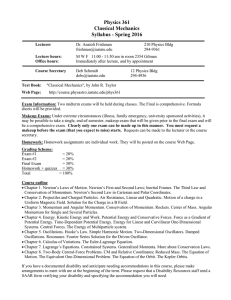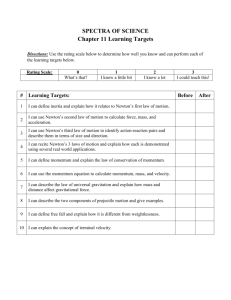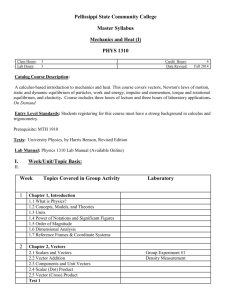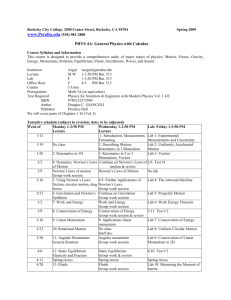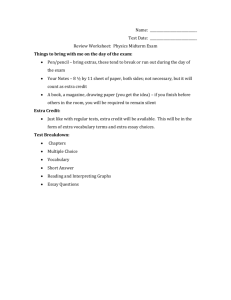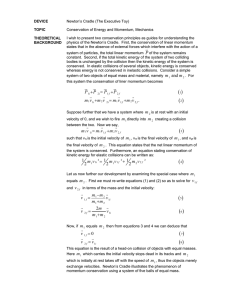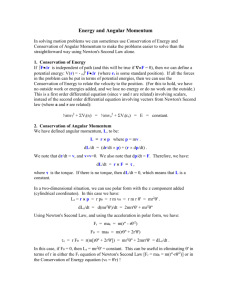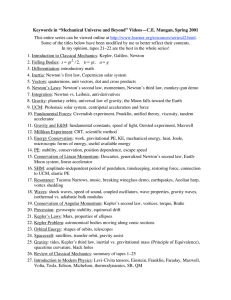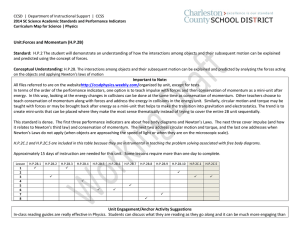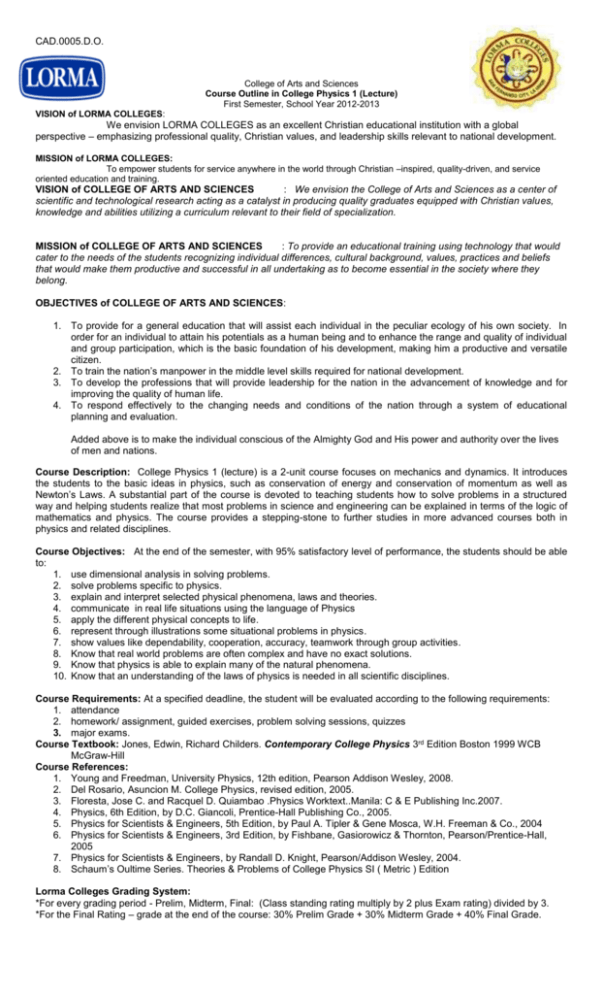
CAD.0005.D.O.
College of Arts and Sciences
Course Outline in College Physics 1 (Lecture)
First Semester, School Year 2012-2013
VISION of LORMA COLLEGES:
We envision LORMA COLLEGES as an excellent Christian educational institution with a global
perspective – emphasizing professional quality, Christian values, and leadership skills relevant to national development.
MISSION of LORMA COLLEGES:
To empower students for service anywhere in the world through Christian –inspired, quality-driven, and service
oriented education and training.
VISION of COLLEGE OF ARTS AND SCIENCES
: We envision the College of Arts and Sciences as a center of
scientific and technological research acting as a catalyst in producing quality graduates equipped with Christian values,
knowledge and abilities utilizing a curriculum relevant to their field of specialization.
MISSION of COLLEGE OF ARTS AND SCIENCES
: To provide an educational training using technology that would
cater to the needs of the students recognizing individual differences, cultural background, values, practices and beliefs
that would make them productive and successful in all undertaking as to become essential in the society where they
belong.
OBJECTIVES of COLLEGE OF ARTS AND SCIENCES:
1. To provide for a general education that will assist each individual in the peculiar ecology of his own society. In
order for an individual to attain his potentials as a human being and to enhance the range and quality of individual
and group participation, which is the basic foundation of his development, making him a productive and versatile
citizen.
2. To train the nation’s manpower in the middle level skills required for national development.
3. To develop the professions that will provide leadership for the nation in the advancement of knowledge and for
improving the quality of human life.
4. To respond effectively to the changing needs and conditions of the nation through a system of educational
planning and evaluation.
Added above is to make the individual conscious of the Almighty God and His power and authority over the lives
of men and nations.
Course Description: College Physics 1 (lecture) is a 2-unit course focuses on mechanics and dynamics. It introduces
the students to the basic ideas in physics, such as conservation of energy and conservation of momentum as well as
Newton’s Laws. A substantial part of the course is devoted to teaching students how to solve problems in a structured
way and helping students realize that most problems in science and engineering can be explained in terms of the logic of
mathematics and physics. The course provides a stepping-stone to further studies in more advanced courses both in
physics and related disciplines.
Course Objectives: At the end of the semester, with 95% satisfactory level of performance, the students should be able
to:
1. use dimensional analysis in solving problems.
2. solve problems specific to physics.
3. explain and interpret selected physical phenomena, laws and theories.
4. communicate in real life situations using the language of Physics
5. apply the different physical concepts to life.
6. represent through illustrations some situational problems in physics.
7. show values like dependability, cooperation, accuracy, teamwork through group activities.
8. Know that real world problems are often complex and have no exact solutions.
9. Know that physics is able to explain many of the natural phenomena.
10. Know that an understanding of the laws of physics is needed in all scientific disciplines.
Course Requirements: At a specified deadline, the student will be evaluated according to the following requirements:
1. attendance
2. homework/ assignment, guided exercises, problem solving sessions, quizzes
3. major exams.
Course Textbook: Jones, Edwin, Richard Childers. Contemporary College Physics 3rd Edition Boston 1999 WCB
McGraw-Hill
Course References:
1. Young and Freedman, University Physics, 12th edition, Pearson Addison Wesley, 2008.
2. Del Rosario, Asuncion M. College Physics, revised edition, 2005.
3. Floresta, Jose C. and Racquel D. Quiambao .Physics Worktext..Manila: C & E Publishing Inc.2007.
4. Physics, 6th Edition, by D.C. Giancoli, Prentice-Hall Publishing Co., 2005.
5. Physics for Scientists & Engineers, 5th Edition, by Paul A. Tipler & Gene Mosca, W.H. Freeman & Co., 2004
6. Physics for Scientists & Engineers, 3rd Edition, by Fishbane, Gasiorowicz & Thornton, Pearson/Prentice-Hall,
2005
7. Physics for Scientists & Engineers, by Randall D. Knight, Pearson/Addison Wesley, 2004.
8. Schaum’s Oultime Series. Theories & Problems of College Physics SI ( Metric ) Edition
Lorma Colleges Grading System:
*For every grading period - Prelim, Midterm, Final: (Class standing rating multiply by 2 plus Exam rating) divided by 3.
*For the Final Rating – grade at the end of the course: 30% Prelim Grade + 30% Midterm Grade + 40% Final Grade.
Course Topics:
I. The Basic Tools of Physics
a) Units of Measurement
b) Dimensional Analysis
c) Significant Figures
d) Order-of-Magnitude Calculations
e) Coordinate Systems
f) Vectors and Scalars
g) Components of a Vector
II. Motion in One and Two Dimensions
a) Average Velocity; Instantaneous Velocity
b) Acceleration
c) One-Dimensional Motion with Constant Acceleration
d) Freely Falling Bodies
e) Velocity and Acceleration in Two Dimensions
f) Projectile Motion
III. The Laws of Motion
a) Force
b) Newton’s First Law
c) Newton’s Second Law
d) Newton’s Third Law
e) Applications of Newton’s Laws
f) Friction
IV. Objects in Equilibrium
a) The First Condition for Equilibrium
b) Problem-solving Techniques
c) Torque
d) The Second Condition for Equilibrium
e) The Center of Gravity
f) Examples of Objects in Equilibrium
V. Work and Energy
a) Work and Kinetic Energy
b) Gravitational Kinetic Energy
c) Conservative and Nonconservative Forces
d) Conservation of Mechanical Energy
e) Nonconservative Forces and the Work-Energy Theorem
f) Power
g) Work Done by Varying Forces
VI. Momentum and Collisions
a) Momentum and Impulse
b) Conservation of Momentum
c) Elastic and Inelastic Collisions
d) Glancing Collisions
e) Center of Mass
Prepared by:
Engr. Bernardo F. Vallo
CCSE Instructor
Noted and checked by:
Josephine E. Libatique, MALT
Dean Arts and Sciences
Approved by:
Diadema B. La Madrid, Ph.D.
Dean, Academic Affairs


